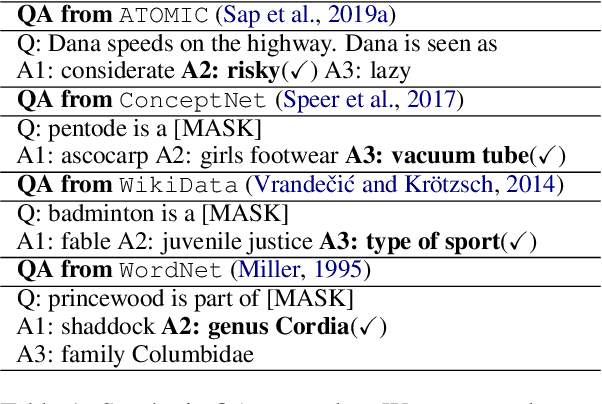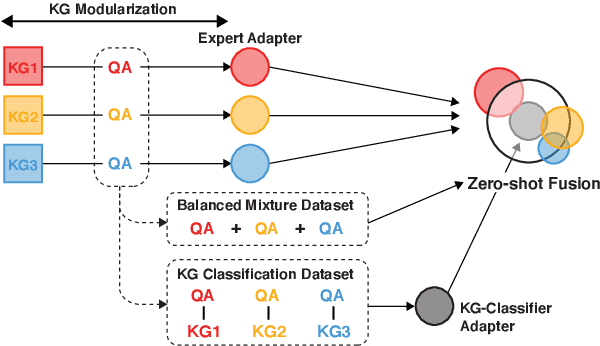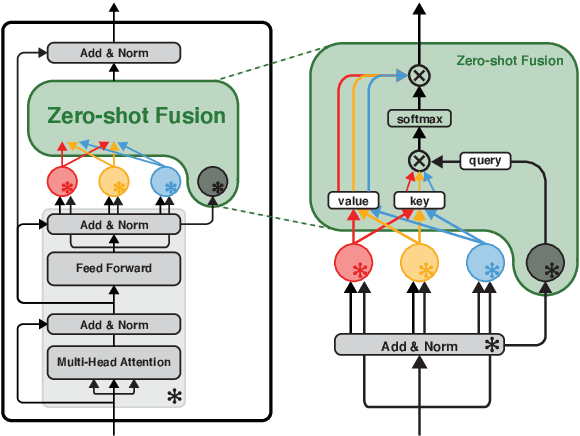Reinald Kim Amplayo
Agents' Room: Narrative Generation through Multi-step Collaboration
Oct 03, 2024Abstract:Writing compelling fiction is a multifaceted process combining elements such as crafting a plot, developing interesting characters, and using evocative language. While large language models (LLMs) show promise for story writing, they currently rely heavily on intricate prompting, which limits their use. We propose Agents' Room, a generation framework inspired by narrative theory, that decomposes narrative writing into subtasks tackled by specialized agents. To illustrate our method, we introduce Tell Me A Story, a high-quality dataset of complex writing prompts and human-written stories, and a novel evaluation framework designed specifically for assessing long narratives. We show that Agents' Room generates stories that are preferred by expert evaluators over those produced by baseline systems by leveraging collaboration and specialization to decompose the complex story writing task into tractable components. We provide extensive analysis with automated and human-based metrics of the generated output.
Scalable and Domain-General Abstractive Proposition Segmentation
Jun 28, 2024Abstract:Segmenting text into fine-grained units of meaning is important to a wide range of NLP applications. The default approach of segmenting text into sentences is often insufficient, especially since sentences are usually complex enough to include multiple units of meaning that merit separate treatment in the downstream task. We focus on the task of abstractive proposition segmentation: transforming text into simple, self-contained, well-formed sentences. Several recent works have demonstrated the utility of proposition segmentation with few-shot prompted LLMs for downstream tasks such as retrieval-augmented grounding and fact verification. However, this approach does not scale to large amounts of text and may not always extract all the facts from the input text. In this paper, we first introduce evaluation metrics for the task to measure several dimensions of quality. We then propose a scalable, yet accurate, proposition segmentation model. We model proposition segmentation as a supervised task by training LLMs on existing annotated datasets and show that training yields significantly improved results. We further show that by using the fine-tuned LLMs as teachers for annotating large amounts of multi-domain synthetic distillation data, we can train smaller student models with results similar to the teacher LLMs. We then demonstrate that our technique leads to effective domain generalization, by annotating data in two domains outside the original training data and evaluating on them. Finally, as a key contribution of the paper, we share an easy-to-use API for NLP practitioners to use.
Learning to Plan and Generate Text with Citations
Apr 04, 2024Abstract:The increasing demand for the deployment of LLMs in information-seeking scenarios has spurred efforts in creating verifiable systems, which generate responses to queries along with supporting evidence. In this paper, we explore the attribution capabilities of plan-based models which have been recently shown to improve the faithfulness, grounding, and controllability of generated text. We conceptualize plans as a sequence of questions which serve as blueprints of the generated content and its organization. We propose two attribution models that utilize different variants of blueprints, an abstractive model where questions are generated from scratch, and an extractive model where questions are copied from the input. Experiments on long-form question-answering show that planning consistently improves attribution quality. Moreover, the citations generated by blueprint models are more accurate compared to those obtained from LLM-based pipelines lacking a planning component.
Gemini: A Family of Highly Capable Multimodal Models
Dec 19, 2023Abstract:This report introduces a new family of multimodal models, Gemini, that exhibit remarkable capabilities across image, audio, video, and text understanding. The Gemini family consists of Ultra, Pro, and Nano sizes, suitable for applications ranging from complex reasoning tasks to on-device memory-constrained use-cases. Evaluation on a broad range of benchmarks shows that our most-capable Gemini Ultra model advances the state of the art in 30 of 32 of these benchmarks - notably being the first model to achieve human-expert performance on the well-studied exam benchmark MMLU, and improving the state of the art in every one of the 20 multimodal benchmarks we examined. We believe that the new capabilities of Gemini models in cross-modal reasoning and language understanding will enable a wide variety of use cases and we discuss our approach toward deploying them responsibly to users.
$μ$PLAN: Summarizing using a Content Plan as Cross-Lingual Bridge
May 23, 2023



Abstract:Cross-lingual summarization consists of generating a summary in one language given an input document in a different language, allowing for the dissemination of relevant content across speakers of other languages. However, this task remains challenging, mainly because of the need for cross-lingual datasets and the compounded difficulty of summarizing and translating. This work presents $\mu$PLAN, an approach to cross-lingual summarization that uses an intermediate planning step as a cross-lingual bridge. We formulate the plan as a sequence of entities that captures the conceptualization of the summary, i.e. identifying the salient content and expressing in which order to present the information, separate from the surface form. Using a multilingual knowledge base, we align the entities to their canonical designation across languages. $\mu$PLAN models first learn to generate the plan and then continue generating the summary conditioned on the plan and the input. We evaluate our methodology on the XWikis dataset on cross-lingual pairs across four languages and demonstrate that this planning objective achieves state-of-the-art performance in terms of ROUGE and faithfulness scores. Moreover, this planning approach improves the zero-shot transfer to new cross-lingual language pairs compared to non-planning baselines.
Text-Blueprint: An Interactive Platform for Plan-based Conditional Generation
Apr 28, 2023Abstract:While conditional generation models can now generate natural language well enough to create fluent text, it is still difficult to control the generation process, leading to irrelevant, repetitive, and hallucinated content. Recent work shows that planning can be a useful intermediate step to render conditional generation less opaque and more grounded. We present a web browser-based demonstration for query-focused summarization that uses a sequence of question-answer pairs, as a blueprint plan for guiding text generation (i.e., what to say and in what order). We illustrate how users may interact with the generated text and associated plan visualizations, e.g., by editing and modifying the blueprint in order to improve or control the generated output. A short video demonstrating our system is available at https://goo.gle/text-blueprint-demo.
Query Refinement Prompts for Closed-Book Long-Form Question Answering
Oct 31, 2022Abstract:Large language models (LLMs) have been shown to perform well in answering questions and in producing long-form texts, both in few-shot closed-book settings. While the former can be validated using well-known evaluation metrics, the latter is difficult to evaluate. We resolve the difficulties to evaluate long-form output by doing both tasks at once -- to do question answering that requires long-form answers. Such questions tend to be multifaceted, i.e., they may have ambiguities and/or require information from multiple sources. To this end, we define query refinement prompts that encourage LLMs to explicitly express the multifacetedness in questions and generate long-form answers covering multiple facets of the question. Our experiments on two long-form question answering datasets, ASQA and AQuAMuSe, show that using our prompts allows us to outperform fully finetuned models in the closed book setting, as well as achieve results comparable to retrieve-then-generate open-book models.
SMART: Sentences as Basic Units for Text Evaluation
Aug 01, 2022



Abstract:Widely used evaluation metrics for text generation either do not work well with longer texts or fail to evaluate all aspects of text quality. In this paper, we introduce a new metric called SMART to mitigate such limitations. Specifically, We treat sentences as basic units of matching instead of tokens, and use a sentence matching function to soft-match candidate and reference sentences. Candidate sentences are also compared to sentences in the source documents to allow grounding (e.g., factuality) evaluation. Our results show that system-level correlations of our proposed metric with a model-based matching function outperforms all competing metrics on the SummEval summarization meta-evaluation dataset, while the same metric with a string-based matching function is competitive with current model-based metrics. The latter does not use any neural model, which is useful during model development phases where resources can be limited and fast evaluation is required. Finally, we also conducted extensive analyses showing that our proposed metrics work well with longer summaries and are less biased towards specific models.
Conditional Generation with a Question-Answering Blueprint
Jul 01, 2022



Abstract:The ability to convey relevant and faithful information is critical for many tasks in conditional generation and yet remains elusive for neural seq-to-seq models whose outputs often reveal hallucinations and fail to correctly cover important details. In this work, we advocate planning as a useful intermediate representation for rendering conditional generation less opaque and more grounded. Our work proposes a new conceptualization of text plans as a sequence of question-answer (QA) pairs. We enhance existing datasets (e.g., for summarization) with a QA blueprint operating as a proxy for both content selection (i.e.,~what to say) and planning (i.e.,~in what order). We obtain blueprints automatically by exploiting state-of-the-art question generation technology and convert input-output pairs into input-blueprint-output tuples. We develop Transformer-based models, each varying in how they incorporate the blueprint in the generated output (e.g., as a global plan or iteratively). Evaluation across metrics and datasets demonstrates that blueprint models are more factual than alternatives which do not resort to planning and allow tighter control of the generation output.
Modularized Transfer Learning with Multiple Knowledge Graphs for Zero-shot Commonsense Reasoning
Jun 22, 2022



Abstract:Commonsense reasoning systems should be able to generalize to diverse reasoning cases. However, most state-of-the-art approaches depend on expensive data annotations and overfit to a specific benchmark without learning how to perform general semantic reasoning. To overcome these drawbacks, zero-shot QA systems have shown promise as a robust learning scheme by transforming a commonsense knowledge graph (KG) into synthetic QA-form samples for model training. Considering the increasing type of different commonsense KGs, this paper aims to extend the zero-shot transfer learning scenario into multiple-source settings, where different KGs can be utilized synergetically. Towards this goal, we propose to mitigate the loss of knowledge from the interference among the different knowledge sources, by developing a modular variant of the knowledge aggregation as a new zero-shot commonsense reasoning framework. Results on five commonsense reasoning benchmarks demonstrate the efficacy of our framework, improving the performance with multiple KGs.
 Add to Chrome
Add to Chrome Add to Firefox
Add to Firefox Add to Edge
Add to Edge